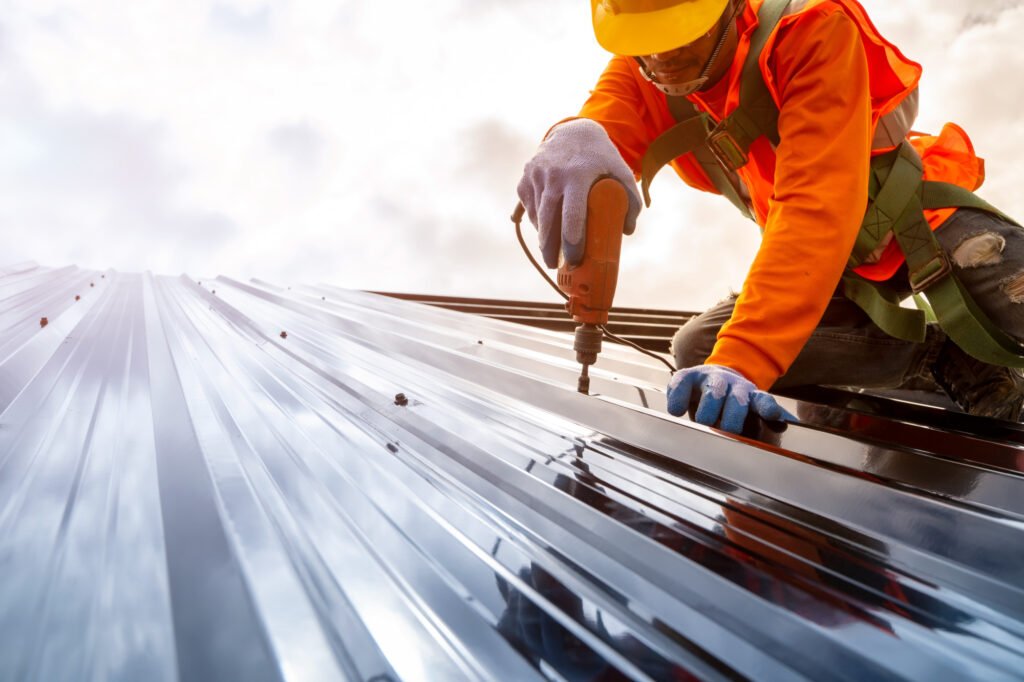When it comes to maintaining and extending the lifespan of a roof, metal roof restoration is a key service that can offer significant benefits. In Hartley, TX, Flatland Roofing & Insulation specializes in this essential service, providing property owners with an effective solution to enhance the durability and performance of their metal roofs. This blog post will explore how restoration works, its benefits, and why choosing the right contractor is crucial.
What is Metal Roof Restoration?
Metal roof restoration is a process designed to revitalize and extend the lifespan of existing metal roofs. Unlike a full roof replacement, restoration involves applying specialized coatings and treatments to the existing roof structure. This method offers a cost-effective way to improve the roof’s condition without the need for a complete overhaul.
Key Components of Metal Roof Restoration
- Inspection and Cleaning: The first step involves a thorough inspection to assess the roof’s condition. This includes identifying any damage, rust, or wear. Cleaning is essential to remove debris, dirt, and old coatings to ensure proper adhesion of the new materials.
- Repairing Damage: Any existing damage, such as leaks or rust, is repaired before applying the restoration materials. This might involve patching holes, replacing damaged panels, or treating rusted areas.
- Applying Coatings: The restoration process typically includes applying a high-quality coating to the roof. This coating forms a protective layer that enhances the roof’s resistance to weather elements and improves its energy efficiency.
- Final Inspection: After the coating is applied, a final inspection ensures that the application is even and that there are no missed spots. This step is crucial for the longevity and effectiveness of the restoration.
Benefits of Metal Roof Restoration
Choosing roof restoration offers several advantages over a complete roof replacement. Here’s a closer look at the key benefits:
Extended Roof Life
One of the primary benefits of metal roof restoration is its ability to extend the roof’s life. By applying protective coatings, restoration helps prevent further deterioration and can add years to the roof’s lifespan. This approach is often more cost-effective than replacing the roof entirely.
Improved Energy Efficiency
Restoring a metal roof can enhance energy efficiency. Reflective coatings used in restoration processes help to reduce heat absorption, which in turn lowers cooling costs. This can be particularly beneficial in areas with hot climates.
Cost-Effectiveness
Compared to a full roof replacement, roof restoration is generally more affordable. It avoids the costs associated with removing and disposing of the old roof, as well as the installation of a new one. This makes it an attractive option for budget-conscious property owners.
Enhanced Protection
The coatings used in restoration provide an additional layer of protection against environmental factors such as UV rays, rain, and snow. This helps to prevent issues like rust, leaks, and other forms of damage.
Aesthetic Improvement
Restoration can also improve the appearance of an old, worn-out roof. New coatings can refresh the roof’s look, making it more visually appealing without the need for a complete replacement.
The Metal Roof Restoration Process
Understanding the restoration process can help property owners appreciate the value of this service. Here’s a breakdown of what to expect:
Initial Inspection
The restoration process begins with a detailed inspection of the metal roof. This assessment identifies any existing issues that need to be addressed before the restoration can proceed. The inspector will check for rust, leaks, and other damage.
Surface Preparation
Proper preparation is crucial for a successful restoration. This involves cleaning the roof surface to remove any dirt, debris, or old coatings. Surface preparation ensures that the new coating adheres properly and performs effectively.
Repair Work
Any necessary repairs are made to address damage identified during the inspection. This may involve fixing leaks, patching holes, or treating rusted areas. Proper repair work is essential to ensure the longevity and effectiveness of the restoration.
Coating Application
Once the roof is prepared, a high-quality coating is applied. This coating acts as a protective layer and can come in various types, including acrylic, silicone, and polyurethane. The choice of coating depends on the roof’s specific needs and the environmental conditions.
Final Inspection
After the coating has been applied and has had time to cure, a final inspection is conducted. This ensures that the coating is evenly applied and that there are no areas that have been missed. The final inspection helps to confirm that the restoration has been completed to a high standard.
Choosing the Right Contractor for Metal Roof Restoration
Selecting a qualified contractor is crucial for a successful roof restoration project. Here are some tips to help you choose the right professional:
Experience and Expertise
Look for a contractor with extensive experience in metal roof restoration. Experienced professionals are more likely to deliver high-quality results and handle any challenges that may arise during the project.
Reputation and Reviews
Check reviews and ask for references from previous clients. Positive feedback and recommendations can provide insight into the contractor’s reliability and workmanship.
Licensing and Insurance
Ensure that the contractor is licensed and insured. This protects in case of any issues or accidents during the restoration process.
Detailed Proposal
Request a detailed proposal that outlines the scope of work, materials to be used, and the project timeline. A clear proposal helps to set expectations and avoid misunderstandings.
FAQs
What is the Difference Between Restoration and Replacement?
Restoration involves applying coatings and treatments to an existing roof to extend its life and improve its performance. Replacement involves removing the old roof and installing a new one. Restoration is generally more cost-effective and less disruptive.
How Long Does Metal Roof Restoration Last?
The longevity of a metal roof restoration depends on the type of coating used, the condition of the roof, and environmental factors. Generally, restored roofs can last between 10 and 15 years before requiring another restoration.
Can Metal Roof Restoration Fix Leaks?
Metal roof restoration can address and seal minor leaks, but significant leaks may require additional repairs. It’s essential to address major leaks before applying a restoration coating to ensure a long-lasting result.
How Do I Know if My Roof Needs Restoration?
Signs that your roof may need restoration include visible rust, leaks, damaged panels, or a general decline in appearance. A professional inspection can help determine if restoration is a suitable option.
Is Metal Roof Restoration a DIY Project?
While some aspects of roof maintenance can be handled by DIY enthusiasts, metal roof restoration is best left to professionals. Proper application of coatings and handling of repairs require specialized knowledge and equipment.
Conclusion
Metal roof restoration offers a valuable solution for extending the life of your roof and enhancing its performance. In Hartley, TX, Flatland Roofing & Insulation specializes in this essential service, providing property owners with a cost-effective way to maintain and improve their metal roofs. By choosing a qualified contractor and understanding the restoration process, you can ensure that your roof remains in excellent condition for years to come.For more information about metal roof restoration services, contact Flatland Roofing & Insulation at (806) 268-0852. Their experienced team is ready to assist with all your roof.





Your writing style makes complex topics seem simple. Thanks!
кайт школа хургада
Rainbet bonus code ILBET Откройте для себя мир Rainbet, где каждый спин и каждая ставка – это шанс на крупный выигрыш. Промокод ILBET станет вашим верным спутником в этом путешествии, открывая двери к эксклюзивным бонусам и специальным предложениям. Не упустите возможность максимизировать свои выгоды с самого начала.
Стратегическое планирование Оптимизация процессов: повысьте эффективность и сократите расходы. Задумывались ли вы, почему ваши бизнес-процессы иногда работают неэффективно? Оптимизация — это не только снижение затрат, но и улучшение качества, скорости и удовлетворенности клиентов. Опытный ментор поможет вам выявить слабые места, внедрить современные методы и автоматизировать рутинные задачи. В результате вы построите бизнес, который работает как часы, а ресурсы используются максимально эффективно. Не позволяйте неэффективности замедлять рост — закажите консультацию и получите экспертную поддержку в трансформации вашего бизнеса.
красное море температура воды
zarabianie przez internet dla kobiet Стань вебкам моделью в польской студии, работающей в Варшаве! Открыты вакансии для девушек в Польше, особенно для тех, кто говорит по-русски. Ищешь способ заработать онлайн в Польше? Предлагаем подработку для девушек в Варшаве с возможностью работы в интернете, даже с проживанием. Рассматриваешь удаленную работу в Польше? Узнай, как стать вебкам моделью и сколько можно заработать. Работа для украинок в Варшаве и высокооплачиваемые возможности для девушек в Польше ждут тебя. Мы предлагаем легальную вебкам работу в Польше, онлайн работа без необходимости знания польского языка. Приглашаем девушек без опыта в Варшаве в нашу вебкам студию с обучением. Возможность заработка в интернете без вложений. Работа моделью онлайн в Польше — это шанс для тебя! Ищешь “praca dla dziewczyn online”, “praca webcam Polska”, “praca modelka online” или “zarabianie przez internet dla kobiet”? Наше “agencja webcam Warszawa” и “webcam studio Polska” предлагают “praca dla mlodych kobiet Warszawa” и “legalna praca online Polska”. Смотри “oferty pracy dla Ukrainek w Polsce” и “praca z domu dla dziewczyn”.
температура воды в хургаде
I loved as much as you’ll receive carried out right here. The sketch is attractive, your authored subject matter stylish. nonetheless, you command get bought an shakiness over that you wish be delivering the following. unwell unquestionably come further formerly again since exactly the same nearly a lot often inside case you shield this hike.
Dismemberment